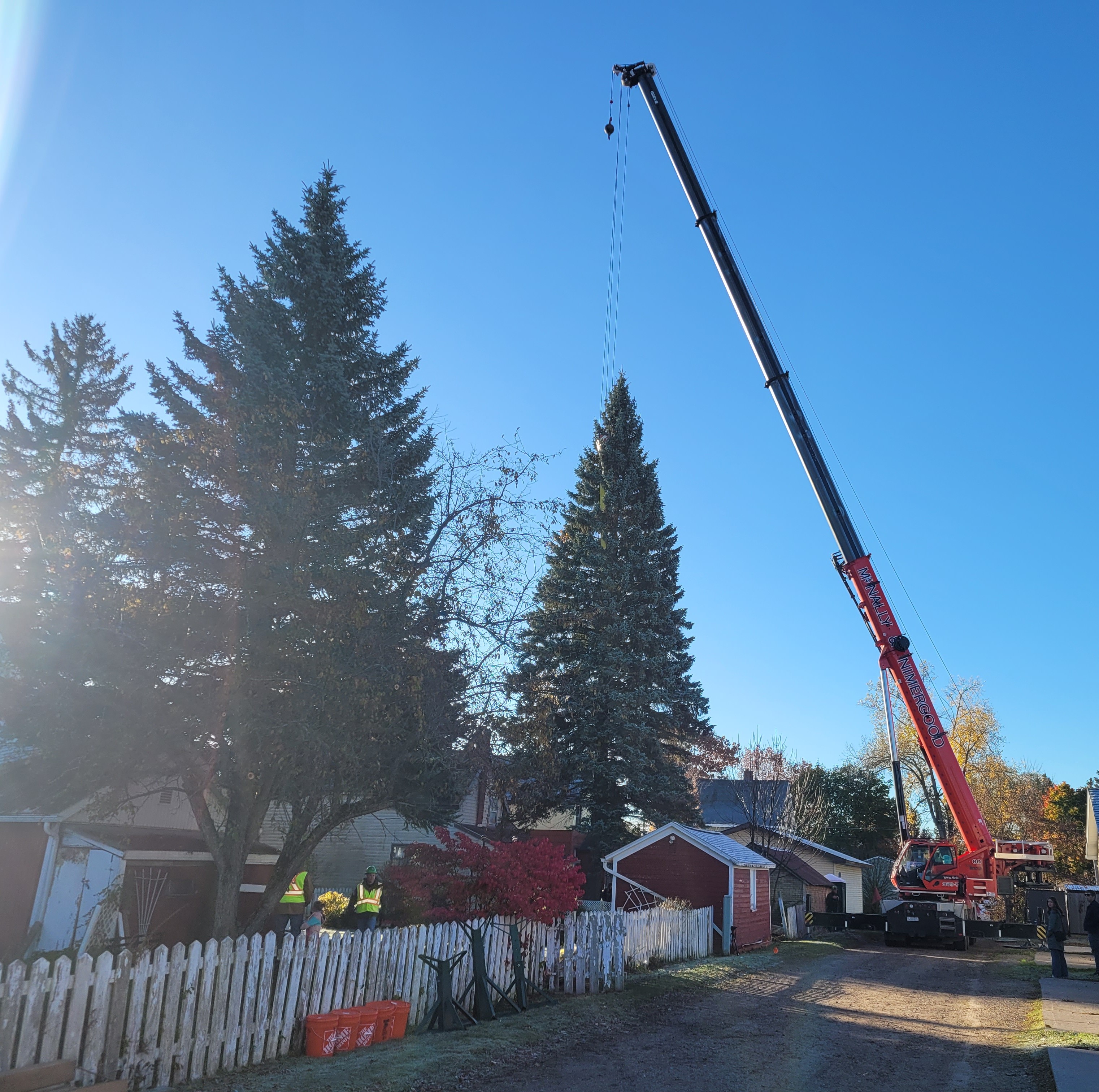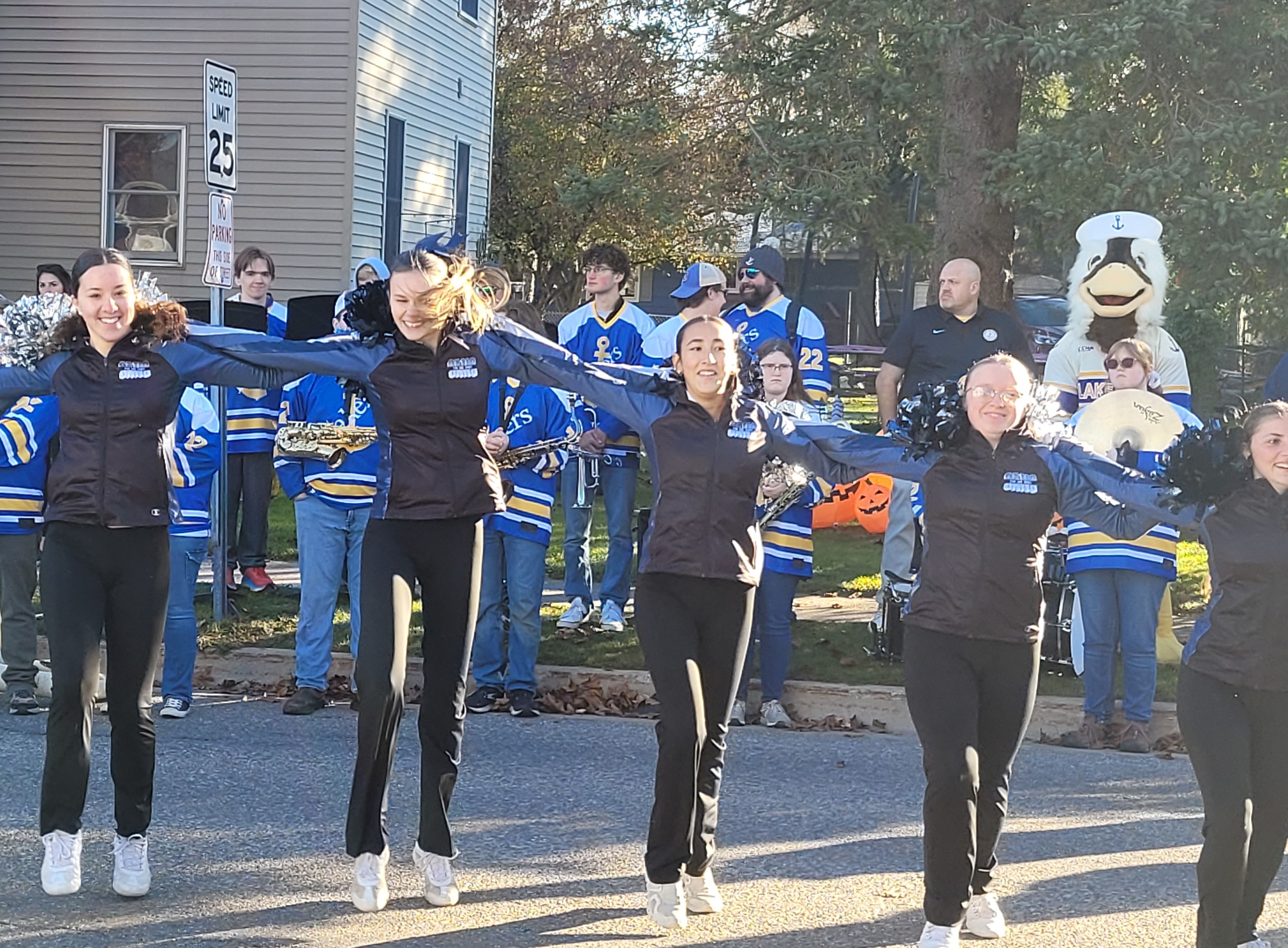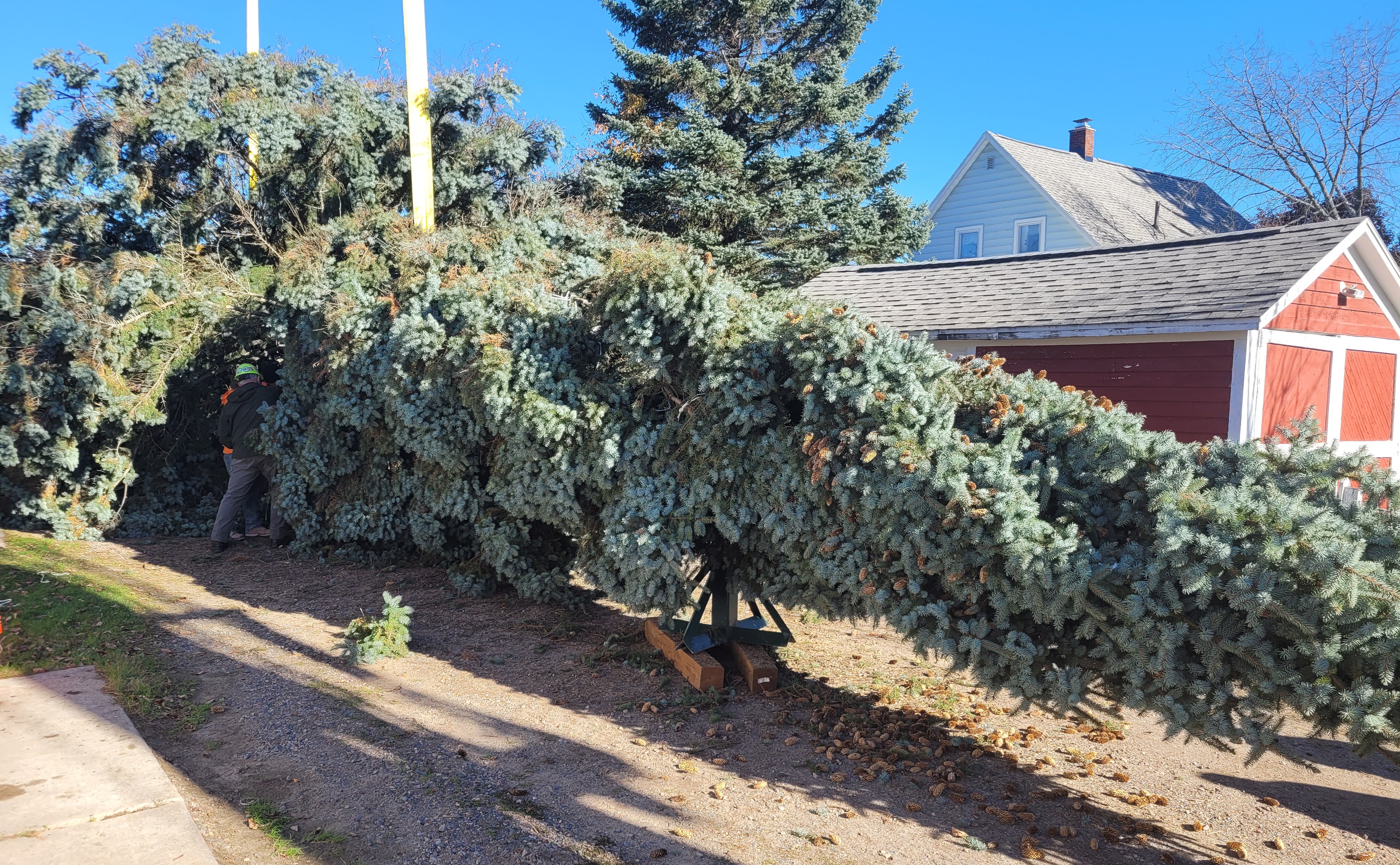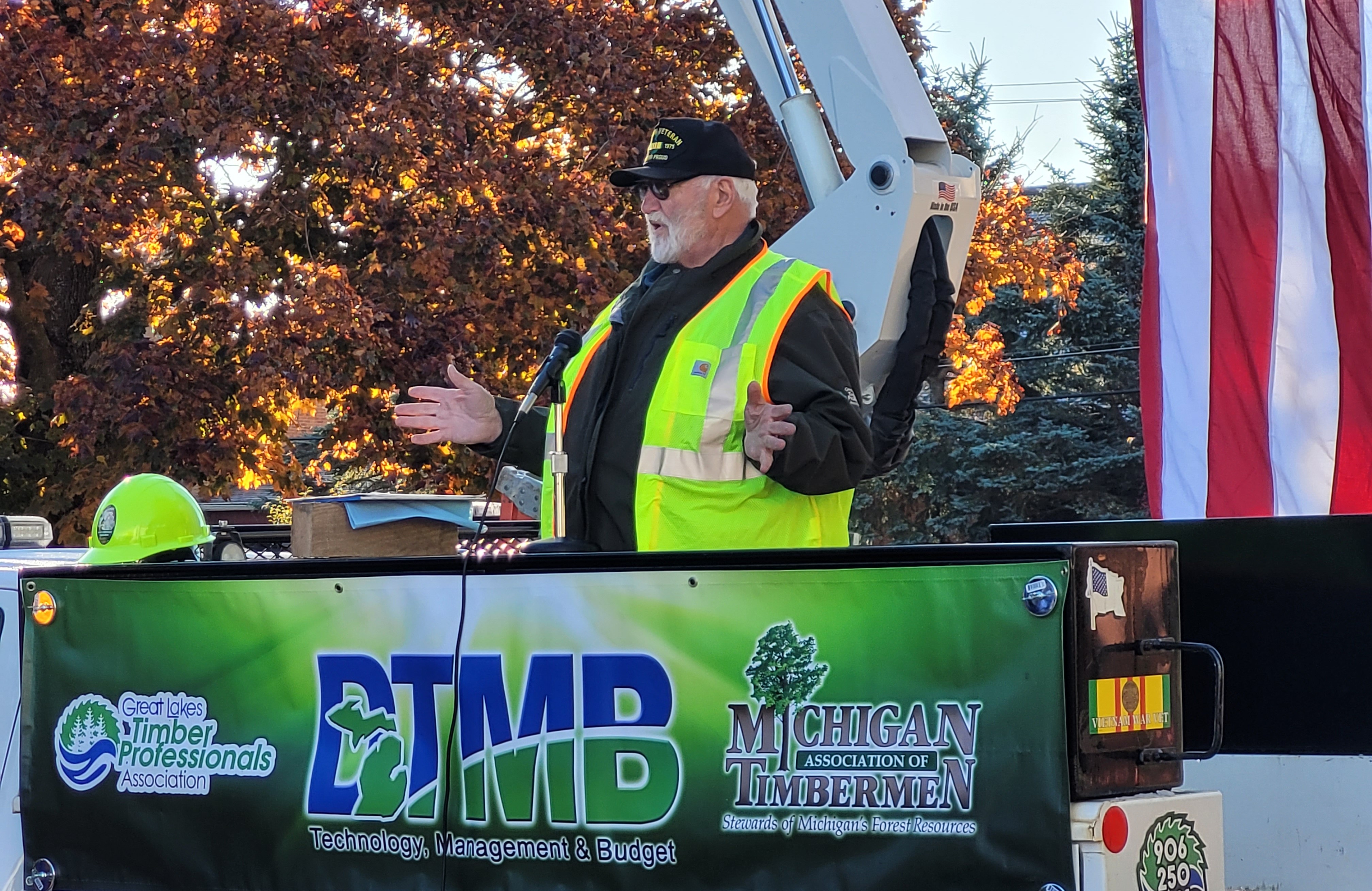Capitol Christmas Trees
State Christmas Tree Harvested at Soo, MI
The Yule tide spirit echoed through the streets of Sault Saint Marie, MI, on October 30, 2025. The Soo, as it is more commonly known to Michiganders and our Lake State neighbors, was once again chosen by The Michigan Department of Technology, Management and Budget to provide the 2025 State Christmas tree.
The program to celebrate the harvest was organized under the able leadership of GLTPA, led by Denny Olson, Director of Michigan Affairs, in coordination with the Michigan Department of Technology, Management and Budget [DTMB], represented by Michelle Lange and Heath Miller. GLTPA president Mike Elenz, and Executive Director Henry Schienebeck were also in attendance.
The official State Christmas tree, a 68-foot blue spruce, was donated by the family of Linda Ried and will be transported to the State Capital in Lansing where it will be on display for the duration of the 2025 Christmas holiday season.
Linda Ried was overwhelmed to learn that the family had been selected to provide the state with the tree that had been planted by her deceased Grandparents, Lawrence and Nettie Richey. Linda commented, “that she spent a lot of time with her grandparents at the Soo and that they would be so proud to know their tree had been selected as the State Christmas tree”. The tree planted at their residence was generally thought to have been “dug out of the woods” and as proudly stated by Linda, “my grandma planted it the backyard the same year I was born, 1954”. So, there we have it, an official confirmation of 71 years, since the tiny Blue spruce seedling was planted at the Richey back yard location. Better than taking a tree boring or counting rings with a hand lens on the massive stump of this beautiful specimen!
The program began promptly at 10 A. M with a posting of the colors by Vietnam Veterans local Post 180 during the playing of the National Anthem. The Pledge of Allegiance was led by local Soo students Ava Povey and Madison Knaff. The invocation for the event was offered by Heath Miller of DTMB.
A typical Denny ‘welcome’ was extended to the enthusiastic locals as Mayor Don Gerrie was introduced to express the Soo’s appreciation for the prestigious event. A GLTPA ‘high five’ is also extended to Linda Hoath representing the Sault Saint Marie Convention and Visitors Bureau for the wonderful cooperation in bringing all the players together for the seasonal celebration. Particular appreciation and ‘thank you’ was offered to the youth in attendance, the Sault High School band, the LSSU Band and the Sault Area Poms Dance group.
Denny then acknowledged agencies and partners that have contributed to the annual selection and harvest of the state Christmas tree.
Justin Knepper from the Michigan Association of Timbermen [MAT] cited the long- standing relationship with GLTPA and the Michigan Department of Technology, Management and Budget [DTMB]. Knepper reaffirmed the positive role the Newberry based association has played in the growth and strengthening of Michigan’s forest industry since 1972 as ‘Stewards of Michigan’s Forest Resources”. MAT members represent Michigan’s forestry community as those who grow, harvest, and process forest products.
Citing the economic strength of Michigan’s forest Industry and the critical role that timber has played in the historical development of the State, the continued commitment to partner with government, community and cultural values was expressed by Michelle Lange, Director of DTMB.

The tradition to placing a native grown tree at the State Capital in Lansing was begun by Governor James Blanchard in 1987, recognizing the 150-year anniversary of Michigan statehood in 1837. This Christmas of 2025 marks the 39th year of tradition, and it is significant to note that the Upper Peninsula has provided 25 of the State trees and Sault Saint Marie has yielded the State tree 3 times.
Blue spruce carries the scientific name of Picea pungens and is often considered to be a native spruce tree in Michigan, but the fact of the matter tells us the tree is native to the Rocky Mountain region. Hence, the names blue spruce and Colorado blue spruce are identifying the same tree. According to the field handbook MICHIGAN TREES by Charles H. Otis, The University of Michigan Press, there are only two spruces native to Michigan, the white spruce and black spruce.
The Colorado blue spruce happens to adapt very well to the Lake States climate and has therefore been sold by nurseries and planted as an ornamental in residential areas and parks. However, thanks to the native habits of birds and squirrels, blue spruce cones [seeds] are often relocated into the natural forest to germinate and grow very well in modestly competitive situations.
From the land of the official Yooper-made headgear, the strong community turn out for the tree harvest is a testament to the Soo’s pride representing the State’s southern neighbor to Canada, the Soo Locks and the States “original hockey town” dating back to the era of the Detroit Red Wings hockey training headquarters from the days of Gordie Howe.
This year’s tree event ushered in the Christmas season festivities with performances provided by the Sault High School band, the Sault Area Poms Dance, and the Lake Superior State University’s pep band. A surprise visit by LSSU mascot ‘Seamore the Sea Duck’ was captured in the photo top right, as the crowd lined sidewalks on both sides of the street while enjoying the Patriotic and seasonal songs by the respective bands. The only thing absent was that anticipated word, SNOW…as the bands rendition of ‘Frosty the Snowman’ and ‘Santa Clause Is Coming To Town’ warmed the hearts of the faithful following on that crisp October morning.

The anticipated moment had arrived, and Denny Olson led the countdown to ‘gentlemen, start your saw’! A single Husky in the hands of the skilled sawyer Ron Papin of Grade A Logging severed the towering spruce from the stump and the State Christmas tree gently swayed on the cable attached to the crane provided by McNally Crane. The tree was lowered onto a waiting trailer and semi-tractor allowing the task of preparing the spruce for travel to Lansing, requiring careful folding and securing of the branches to the main trunk protecting the perfect conical shape of the majestic blue spruce.
Transportation of the State tree to Lansing was provided by Chris Muma Forest Products with driver Ray (The Great) Good negotiating the 300-mile journey to Lansing, scheduled to arrive on November 1. The low-boy trailer for the event was provided by Ken Augustine of Beaverton, MI. and provided the platform for the preparation and long haul. A big ‘thank you” to The Michigan Operating Engineers Local 324, for their decade of involvement in preparation for harvest of the State Christmas tree.
Once the tree arrives in Lansing it will be entrusted to the city’s Forestry Team to be secured for decoration in preparation for the official lighting ceremony under the able supervision of Mindy Biladeau of Lansing’s Silver Bells. The official lighting of the State Christmas Tree was scheduled for November 21 and will grace the downtown capital area for the duration of the holidays.
Denny Olson reported, “this year’s event was one of the most successful and smoothest Christmas Tree Harvest celebration we could have arranged and on behalf of GLTPA, heartfelt thanks to all that made this year’s event so enjoyable with the safe and timely delivery of the tree to the State Capital”.
A special thanks to the generous neighbor that provided ‘the back yard space’ to Carmel (Apple) Olson for preparation of the hot coffee and yummy snacks for the crew and all who stopped by. As the morning came to a close and over a raised cup of steaming hot coffee, Denny Olson proclaimed the timely reminder, JESUS IS THE REASON FOR THE SEASON.

